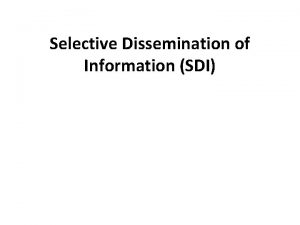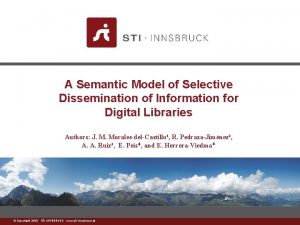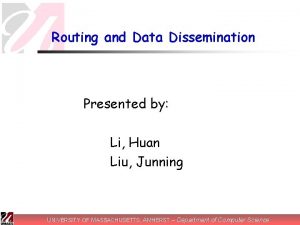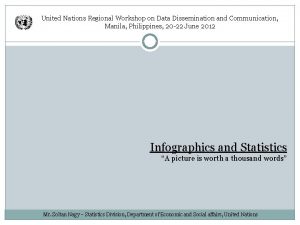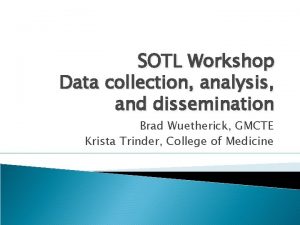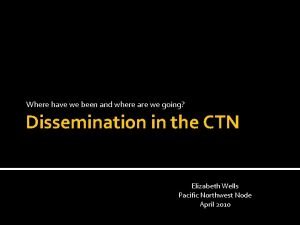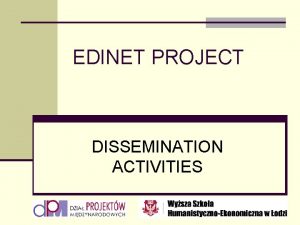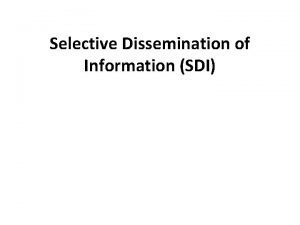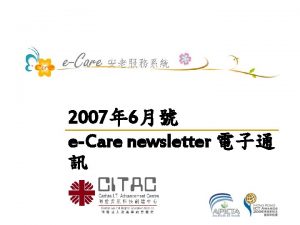INFORMATION DISSEMINATION TECHNIQUES INFORMATION DISSEMINATION TECHNIQUES Community newsletter











- Slides: 11

INFORMATION DISSEMINATION TECHNIQUES

INFORMATION DISSEMINATION TECHNIQUES Community newsletter Information campaigns Community radio Training workshops Field visits Internet services Expert advice Databases of local information

Community newsletter A newsletter serves the purpose of informing the community about what is going on and what is planned in information-sharing and exchange activities. The newsletter could be issued every second month or more frequently when there is important news to share. **Put copies of the newsletter on notice boards at your e. Centre and in other public places, including religious places and shops.

Information campaigns The concept of campaigns refers to focused and intense information exchange around a specific issue, for a specified period of time. This type of communication helps to create the needed social climate for the development and adoption of new ideas on a particular topic. Information campaigns may be organised around topics, such as family planning and the use of contraceptives, HIV/AIDS awareness, equal rights for girls, tree planting, environmental awareness, and literacy, to mention a few examples. Campaigns may be also needed to support services being offered by some other agency or programme.

Community radio is the radio of the community, in the community, for the community, about the community and by the community. It is a medium that gives voice to the voiceless that serves as a mouth-piece of the marginalised.

Training workshops Structured training activities in the form of short workshops and seminars are important for the rapid acquisition of knowledge and skills. For example, a group of small farmers can learn together how to grow tomatoes and other horticultural produce. Then, they discuss how best to apply the ideas in their community. The small farmers can also carry out experiments (or pilot projects) to test their learning.

Field visits In most of the developing countries, other communities, NGOs and government departments deal with problems similar to the ones the community is trying to address. A field visit to a nearby village can turn the community members into independent (or self-reliant) knowledge seekers. Through the experience of a visit and exchange, they can look at what others have done, and decide which of the practices can be adopted and adapted for their community. The role of the e. Centre is to first identify potential places for field visits. Then, if it seems a good idea, the workers could discuss the goals of such a visit with the community. If applicable, experiments (or pilot projects) can once again be carried out on a small scale, in order to test the idea and its possible adaptation in the community. During the pilot project, it is possible to find out potential problems that were not evident during the short field visit. The principle, in this type of activity, is to strengthen the community’s capacity building to evaluate and adapt knowledge from the outside world to suit its own social situation and values.

Internet services The most exciting tool for communicating information is the Internet. The Internet is a vast network of computers linked throughout the world through telephone lines or telecommunication satellites. It provides public access to large stores of information. As a communication tool, the Internet allows communities and individuals to do the following: Exchange messages through electronic mail or e-Mail. Search information on the Internet, using the World Wide Web (www) and anonymous suggestions. Put up their own information on the Internet, provided they have a Web address or home page. A few examples of information, which a community can put on the Internet include: the newsletter, products they produce and want to sell throughout the world, and tourist information to attract visitors to the community/ village.

Expert Advice With the help of other NGOs/ organisations, you can liaison with an academic institution or government body for support on expert help based on the community’s information needs. For example, there could be a tie-up with nearby agricultural colleges/ universities and government extension centres, etc. Apart from face-to-face interactions, e-Mail interaction, video conferencing and telephone-based support could also be organised – all depending on the capacity of the e. Centre, the resources available to it and the Internet services the organisation it links with.

Databases of local information Compiling databases for local information is one of the best ways to disseminate the information. In simple term, a database is a collection of organised information that is stored and can be easily retrieved, managed, and updated. Usually, databases have columns that contain different types of attributes and rows that correspond to a single record. A good example could be: if you are building a database of social organisations in your community, you would have columns for Organisation Name, Name of Main Contact, Address and Telephone Number. As you list organisations, you would add rows and store that data. Organisati on name Name of Main contact Address Telephone number XXXXX YYYYY

Given below is a list of information databases that an e. Centre operator must prepare. § § § § § Relevant government offices and officers’ details. Emergency numbers, such as local hospitals, fire brigade, police station, etc. Local job vacancies Village baseline data Information regarding government schemes Market prices of local crops Details of local institutions Information on NGOs and their activities Agri-related information (based on local crops and cropping patterns, allied occupational groups, such as animal husbandry, pisci-culture) Banks and post office details Information on basic rights and legal literacy Transport information (bus routes, timings, etc. ) Tourism-related information Basic information regarding health and first aid Details of local volunteers SHG-related information Indigenous skills and crafts
 Importance of selective dissemination of information
Importance of selective dissemination of information Components of selective dissemination of information
Components of selective dissemination of information Challenges of information dissemination
Challenges of information dissemination What is a dissemination plan
What is a dissemination plan Dissemination
Dissemination Dissemination
Dissemination Dissemination
Dissemination Data dissemination
Data dissemination Dissemination
Dissemination Data dissemination diagram
Data dissemination diagram Collection analysis dissemination of data
Collection analysis dissemination of data Ctn dissemination library
Ctn dissemination library
